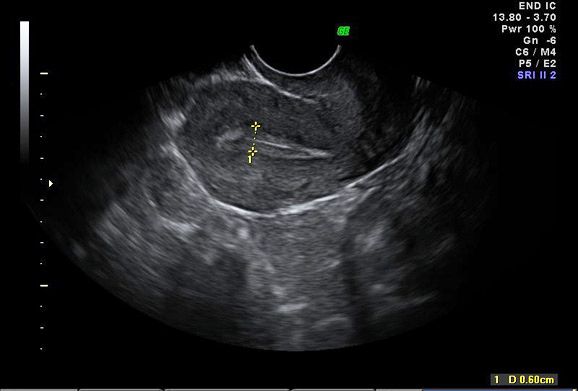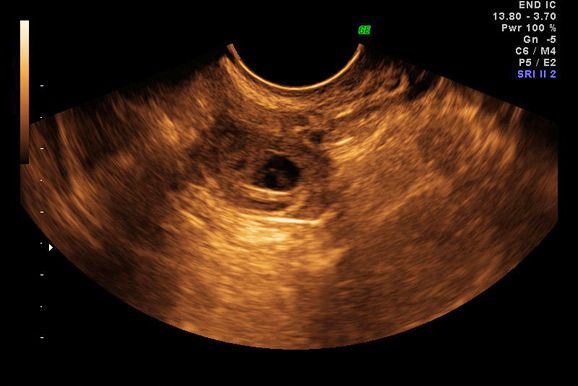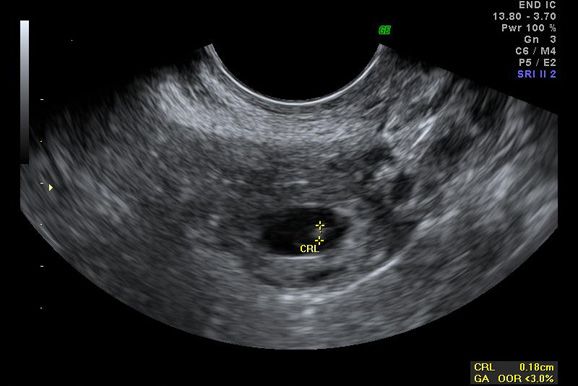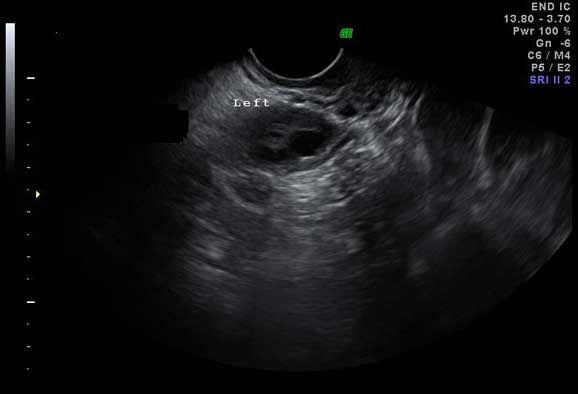Live Ectopic Pregnancy
A 24-year-old pregnant patient presented with lower abdominal pain.
Case History: A 24-year-old pregnant patient presented with lower abdominal pain.

Figure 1: No sac seen in uterus.

Figure 2: Right adenexa with gestational sac.

Figure 3: Fetal pole.

Figure 4. Color doppler shows present of cardiac activity.

Figure 5. Pulsed doppler shows cardiac activity.

Figure 6. Normal left ovary.
Ultrasound showed a well defined sac with decidual reaction in right adnexa separate from right ovary. Yolk sac and fetal pole with cardiac activity noted within sac. No sac seen in uterus. No free fluid seen in Pouch of Douglas.
Diagnosis: Live ectopic pregnancy
Discussion: An ectopic pregnancy, or eccysis, is a complication of pregnancy in which the embryo implants outside the uterine cavity. With rare exceptions, ectopic pregnancies are not viable. Furthermore, they are dangerous for the mother, since internal hemorrhage is a life-threatening complication. Most ectopic pregnancies occur in the Fallopian tube (so-called tubal pregnancies), but implantation can also occur in the cervix, ovaries, and abdomen. An ectopic pregnancy is a potential medical emergency, and, if not treated properly, can lead to death.
In a normal pregnancy, the fertilized egg enters the uterus and settles into the uterine lining where it has plenty of room to divide and grow. About 1 percent of pregnancies are in an ectopic location with implantation not occurring inside of the womb, and of these 98 percent occur in the Fallopian tubes.
Detection of ectopic pregnancy in early gestation has been achieved mainly due to enhanced diagnostic capability. Despite all these notable successes in diagnostics and detection techniques ectopic pregnancy remains a source of serious maternal morbidity and mortality worldwide, especially in countries with poor prenatal care.
In a typical ectopic pregnancy, the embryo adheres to the lining of the fallopian tube and burrows into the tubal lining. Most commonly this invades vessels and will cause bleeding. This intratubal bleeding hematosalpinx expels the implantation out of the tubal end as a tubal abortion. Tubal abortion is a common type of miscarriage. There is no inflammation of the tube in ectopic pregnancy. The pain is caused by prostaglandins released at the implantation site, and by free blood in the peritoneal cavity, which is a local irritant. Sometimes the bleeding might be heavy enough to threaten the health or life of the woman. Usually this degree of bleeding is due to delay in diagnosis, but sometimes, especially if the implantation is in the proximal tube (just before it enters the uterus), it may invade into the nearby Sampson artery, causing heavy bleeding earlier than usual.
If left untreated, about half of ectopic pregnancies will resolve without treatment. These are the tubal abortions. The advent of methotrexate treatment for ectopic pregnancy has reduced the need for surgery; however, surgical intervention is still required in cases where the Fallopian tube has ruptured or is in danger of doing so. This intervention may be laparoscopic or through a larger incision, known as a laparotomy.
Signs and symptoms: Early symptoms are either absent or subtle. Clinical presentation of ectopic pregnancy occurs at a mean of 7.2 weeks after the last normal menstrual period, with a range of five to eight weeks. Later presentations are more common in communities deprived of modern diagnostic ability.
Causes: There are a number of risk factors for ectopic pregnancies. However, in as many as one third to one half, no risk factors can be identified. Risk factors include pelvic inflammatory disease, infertility, use of an intrauterine device (IUD), previous exposure to DES, tubal surgery, intrauterine surgery (e.g. D&C), smoking, previous ectopic pregnancy, and tubal ligation.
An ectopic pregnancy should be considered in any woman with abdominal pain or vaginal bleeding who has a positive pregnancy test. An ultrasound showing a gestational sac with fetal heart in the fallopian tube is clear evidence of ectopic pregnancy.
An abnormal rise in blood β-human chorionic gonadotropin (β-hCG) levels may indicate an ectopic pregnancy. The threshold of discrimination of intrauterine pregnancy is around 1500 IU/ml of β-hCG. A high resolution, transvaginal ultrasound showing no intrauterine pregnancy is presumptive evidence that an ectopic pregnancy is present if the threshold of discrimination for β-hCG has been reached. An empty uterus with levels higher than 1500 IU/ml may be evidence of an ectopic pregnancy, but may also be consistent with an intrauterine pregnancy which is simply too small to be seen on ultrasound. If the diagnosis is uncertain, it may be necessary to wait a few days and repeat the blood work. This can be done by measuring the β-hCG level approximately 48 hours later and repeating the ultrasound. The serum hCG ratios and logistic regression models appear to be better than absolute single serum hCG level. If the β-hCG falls on repeat examination, this strongly suggests a spontaneous abortion or rupture.
Definitive ultrasonographic diagnosis of an ectopic pregnancy is made in only about 20 percent of cases, when an extrauterine pregnancy is clearly identified (i.e. an extrauterine gestational sac with a yolk sac or fetal pole is visualized). There exist, however, numerous findings that are highly suggestive of ectopic pregnancy, including an empty uterus in a patient with a β-hCG level above the discriminatory zone, an adnexal mass other than a simple cyst (see the image below), echogenic fluid in the cul-de-sac, or anything more than a small amount of fluid in the cul-de-sac.
Harpreet Singh, MD
JP Scan private diagnostic center, Khanna, Punjab, India
Can Ultrasound-Based Radiomics Enhance Differentiation of HER2 Breast Cancer?
March 11th 2025Multicenter research revealed that a combined model of clinical factors and ultrasound-based radiomics exhibited greater than a 23 percent higher per patient-level accuracy rate for identifying HER2 breast cancer than a clinical model.